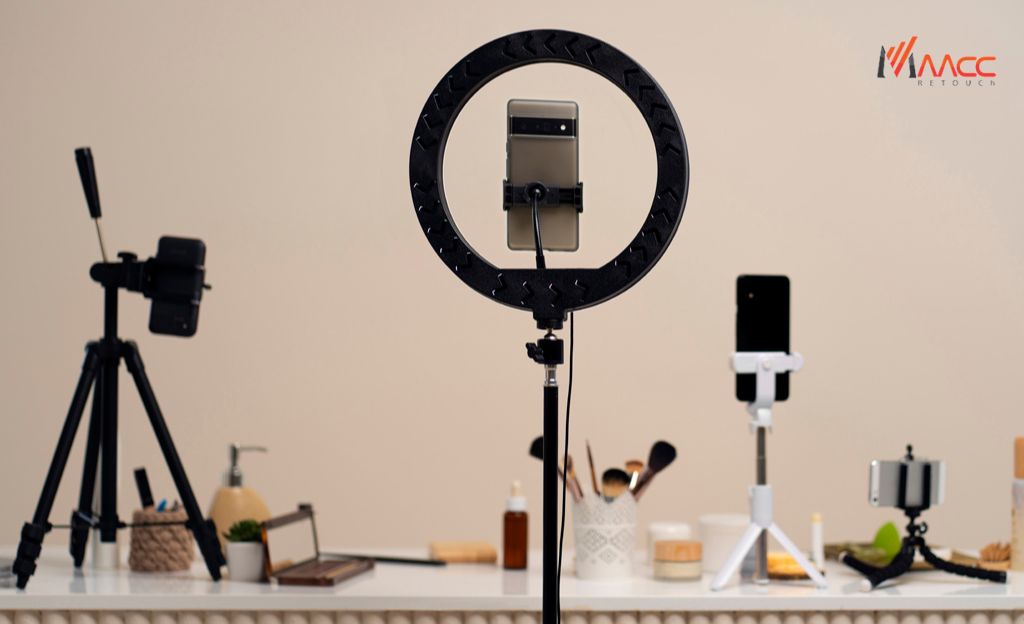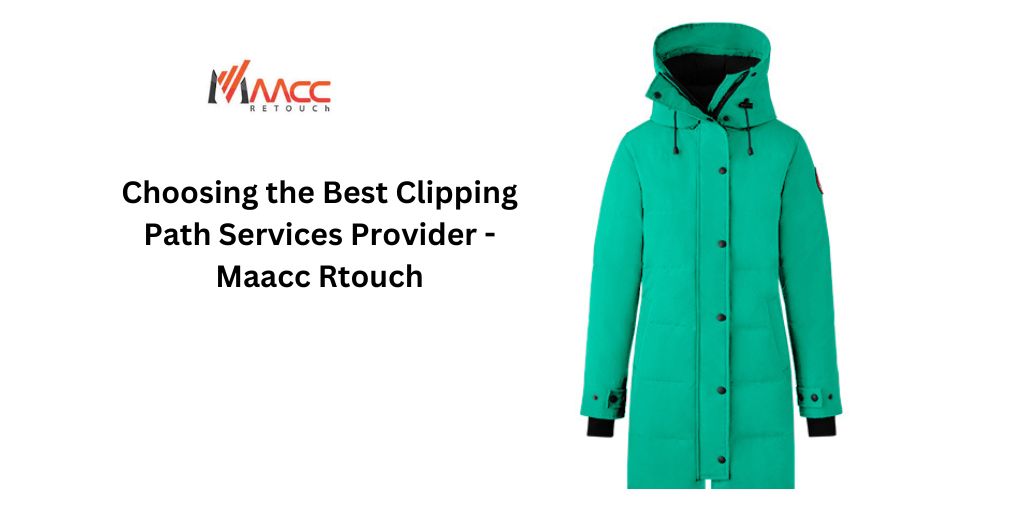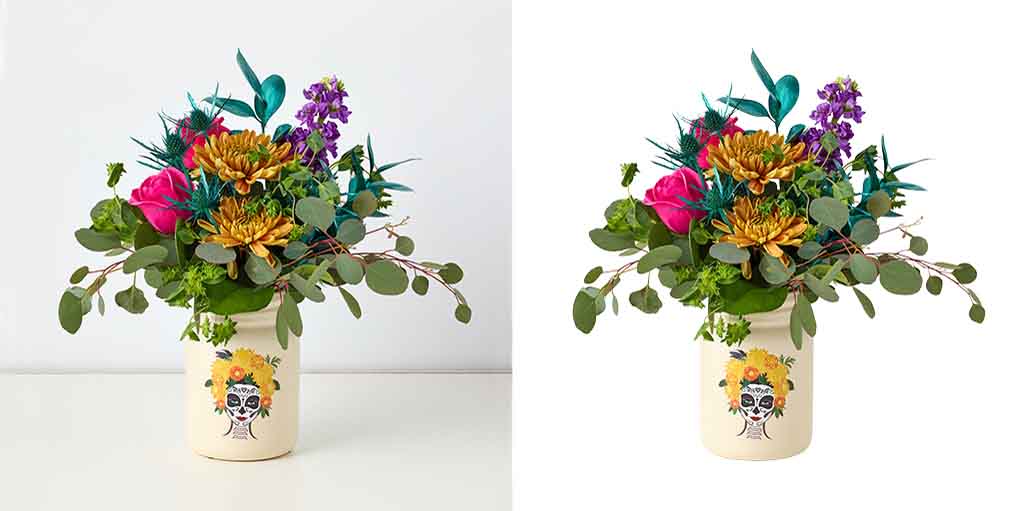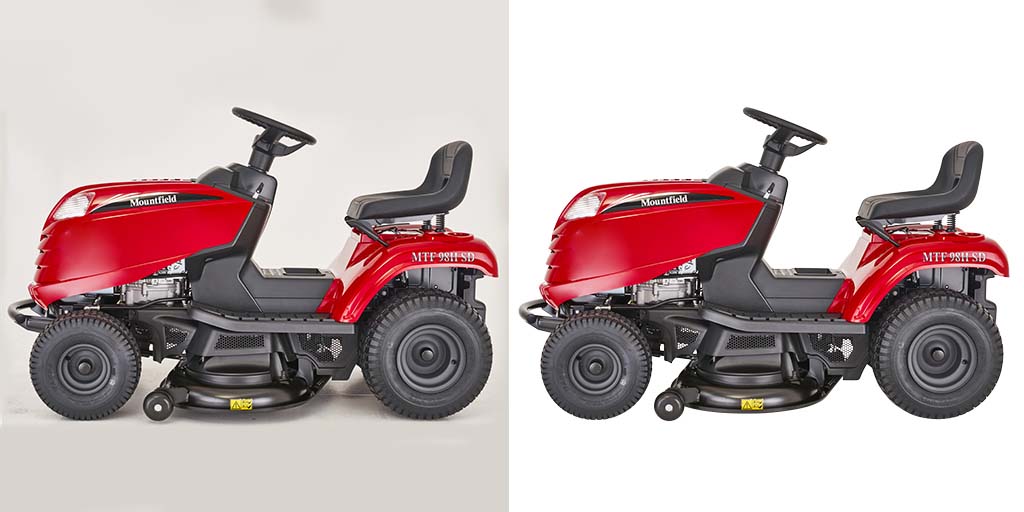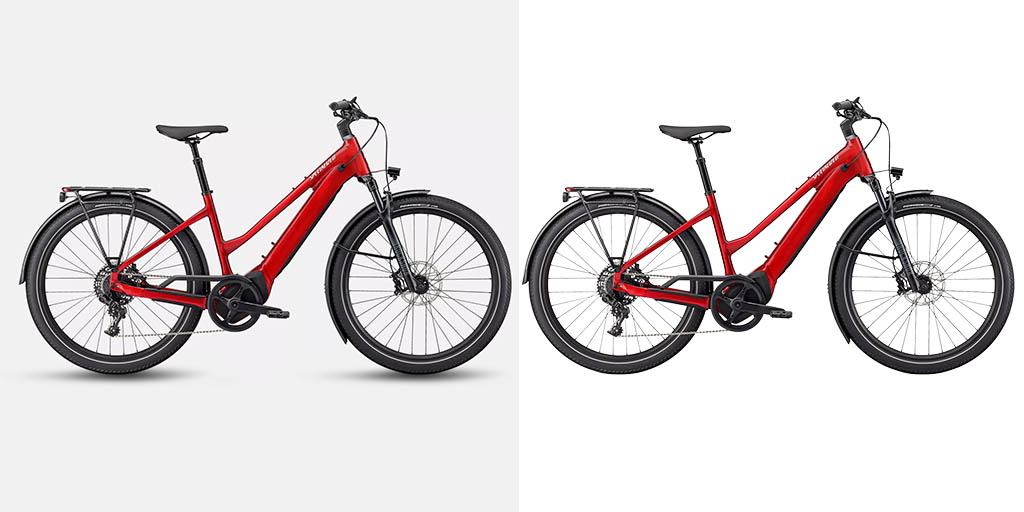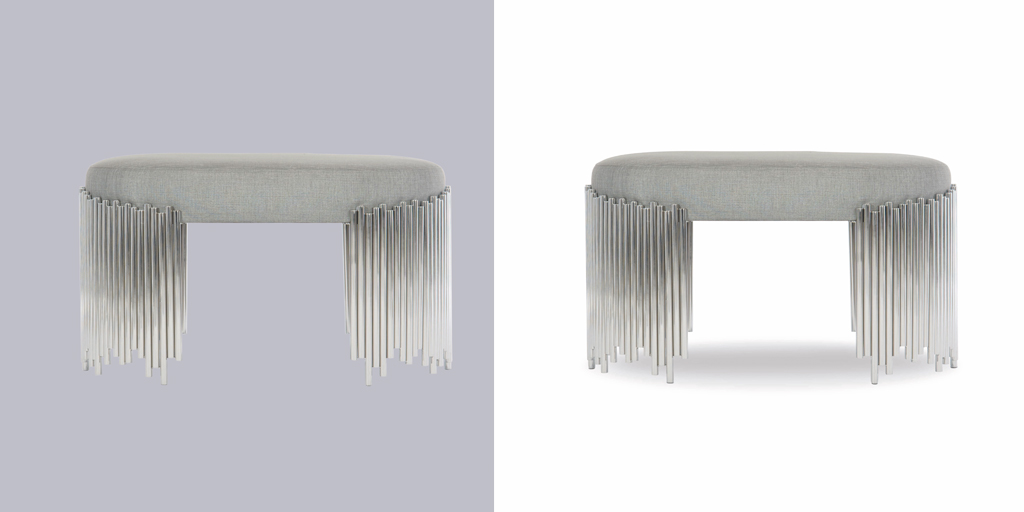Creating compelling product images is a fundamental aspect of successful marketing and e-commerce. Whether you’re an independent seller, a small business owner, or part of a larger retail operation, the art of capturing product images can significantly impact your sales and brand image.
Here we will explore five invaluable product photography tips to help you elevate your visual marketing game. From lighting and composition to equipment and post-processing, mastering these techniques can make a world of difference in how your products are perceived by potential customers. Get ready to take your product photography to the next level with Maacc Retouch’s expert insights.
Different Types of Product Photography
Product photography is a specialized field that involves capturing images of products for commercial use. Different types of product photography serve various purposes, showcasing products in the best possible light to attract customers. Here are some common types of product photography:
White Background/Product-only Shots
White background photography is the epitome of simplicity, offering a blank canvas that ensures the product takes center stage. This style creates a seamless and consistent look across a product catalog, fostering a professional and standardized appearance. It minimizes distractions, making it ideal for e-commerce platforms where clarity and focus on the product are paramount. The absence of contextual elements allows customers to assess the product’s design, color, and features without any visual interference.
Lifestyle/Product in Use
Lifestyle product photography is a storytelling technique that places products in real-life contexts, bridging the gap between the consumer and the item. By portraying products in everyday scenarios, potential buyers can visualize how the product fits into their lives, enhancing the emotional connection. This approach is particularly effective for fashion, home goods, and electronics, as it communicates not just the product’s features but also its practicality and relevance to the consumer’s lifestyle.
Studio/Product on a Colored Background
Studio photography with colored backgrounds injects vibrancy and personality into product visuals. By selecting a background color that complements the product or aligns with brand aesthetics, this style creates a visually cohesive and appealing presentation. It’s an effective way to establish brand identity, differentiate products, and catch the viewer’s attention. The choice of colors can evoke specific emotions and contribute to a brand’s overall visual language, making it a valuable tool for creating a memorable and recognizable product portfolio.
360-Degree Photography
360-degree product photography provides an immersive experience, allowing customers to explore a product from every angle. This interactive approach is especially valuable for online retailers, where customers can rotate and zoom in on the product, gaining a comprehensive understanding of its design and features. It instills confidence in online shoppers by offering a virtual tactile experience, simulating the in-store examination. This technique is particularly beneficial for products with intricate details or unique features that customers want to examine closely before making a purchase.
Close-up/Detail Shots
Close-up or macro product photography zooms in on specific elements, showcasing the finer details of a product. This technique is instrumental in highlighting craftsmanship, texture, and quality, emphasizing features that might go unnoticed in broader shots. It’s particularly effective for products with intricate design elements, such as jewelry, watches, or high-end fashion items. Close-ups create a sense of intimacy, allowing customers to appreciate the product’s artistry and reinforcing the notion of quality and attention to detail.
Flat Lay Photography
Flat lay photography is a visually appealing composition where products are arranged and photographed from a top-down perspective. This style is popular in fashion, beauty, and lifestyle industries, allowing multiple items to be displayed together in a cohesive and stylized manner. Flat lays provide a creative platform to showcase related products, creating a visually engaging story. The overhead view allows for strategic placement and arrangement, conveying a sense of order, balance, and aesthetics in the overall presentation.
Creative/Product with Props
Creative product photography involves incorporating props into the frame, creating a narrative and enhancing the visual appeal of the product. By introducing elements that complement the product, this style goes beyond a simple display, telling a story or conveying a specific mood. It’s commonly used in marketing campaigns to evoke emotions and capture the viewer’s attention. Whether it’s a beverage with strategically placed fruits or a tech gadget in a futuristic setting, creative product photography adds an extra layer of intrigue, making the product more memorable and relatable.
Infographic/Product with Text
Infographic-style product photography integrates text, graphics, or icons to convey key information about the product. This approach is prevalent in the tech industry, where specifications and features are crucial selling points. By combining visual elements with textual information, this style provides a comprehensive overview, making it easier for customers to understand the product’s functionalities, benefits, and unique selling propositions. Infographic product photography is not just about aesthetics; it’s a practical tool for clear communication and informed decision-making.
Environmental/Product in its Setting
Environmental product photography places the product in its natural setting, providing context and authenticity. By showcasing how the product fits into real-life scenarios, consumers can better envision its use and integration into their own lives. This style is particularly effective for products associated with specific lifestyles or activities. Whether it’s outdoor gear in natural landscapes or home decor in a cozy living room, environmental product photography tells a story that resonates with the target audience, making the product more relatable and appealing.
Macro/Product Macro Photography
Macro product photography captures extreme close-ups, revealing intricate details that might go unnoticed in regular shots. This technique is employed to emphasize fine textures, precise craftsmanship, and unique design elements. Common in industries like jewelry, cosmetics, or high-end fashion, macro photography allows customers to appreciate the product’s quality and meticulous attention to detail. It transforms ordinary features into extraordinary focal points, creating a visual experience that transcends the product’s utilitarian purpose.
Packaging/Product with Packaging
Packaging product photography features both the product and its packaging in a single frame. This holistic approach provides a complete view of the product, emphasizing not only its design and features but also the packaging’s aesthetics and functionality. For products where packaging is a key element of the overall appeal, such as cosmetics or consumer electronics, showcasing the entire package helps convey a sense of completeness. It allows consumers to assess not just the product itself but also the care and thought put into its presentation, influencing purchase decisions based on both the product and its packaging.
10 Effective Product Photography Tips
Within the specialisation of e-commerce and visual marketing, product photography is the hidden champion that can make or break your business. Whether you’re an online retailer, a growing entrepreneur, or simply looking to enhance your photography skills, mastering the art of product photography is essential.
To capture stunning product shots that resonate with your audience and drive success in the competitive world of online commerce. So, let’s dive into the world of product photography and unlock the secrets to creating compelling, sales-boosting visuals.
1. Attempt With Lighting
Constant lights are often the optimal choice for product photography lighting since they allow you to preview the placement of reflections and shadows before investing time in capturing the shot. Using proper lighting you can see exactly how the reflections and shadows will fall before capturing the short.
This allows for better control and adjustments in real time, saving valuable time during the shoot. Constant lights also provide a continuous light source, making visualising the final result and making necessary modifications easier.
Additionally, constant lights are ideal for beginners as they offer a simpler setup and require minimal technical knowledge. However, it’s important to consider the potential drawbacks such as heat generation and limited power output.
2. Try Different Angles
Regarding product photography, displaying your item from every possible angle is essential. Customers want to see exactly what they’re getting, and providing multiple views of your product ensures transparency and builds trust. Capture shots that show the front, back, sides, and any unique features or textures. This allows potential buyers to examine the product thoroughly, giving them a better understanding of its appearance and quality before making a purchase. Providing a comprehensive view improves customer satisfaction and reduces the likelihood of returns or dissatisfaction.
3. Usage Rules Of White Balance
White balance is a crucial aspect of photography that determines the accuracy of colors in an image. Understanding the usage rules of white balance is essential to ensure that the colors in your photographs appear natural and true to life.
Just like adjusting the brightness or contrast on a television screen to enhance the viewing experience, adjusting the white balance settings in photography helps to achieve the most accurate and pleasing visual representation.
you can ensure the whites appear truly white, and other colors are accurately represented while you follow the usage rules of white balance. This is particularly important when shooting in different lighting conditions, as different light sources can cast different color temperatures.
4. Highlight Important Product Details
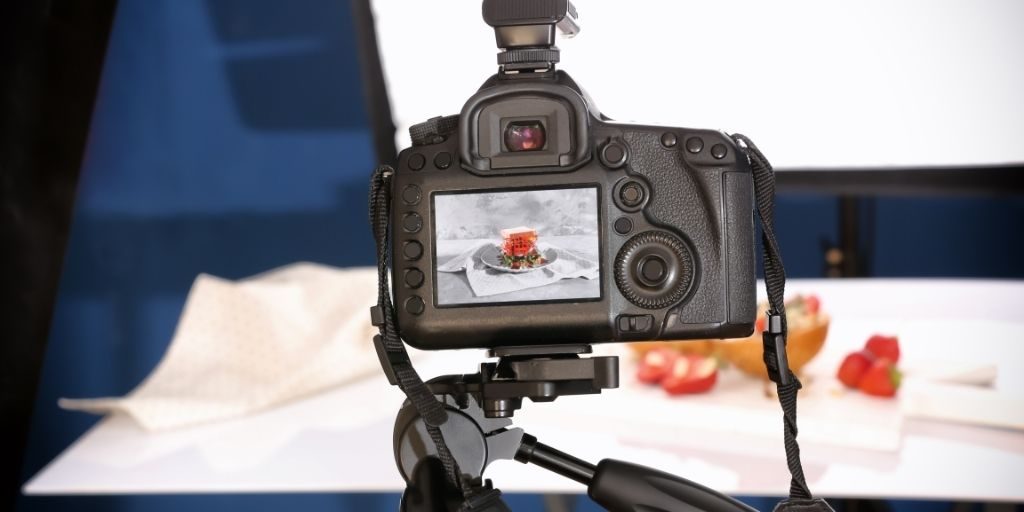
When it comes to showcasing your product effectively, highlighting important details is crucial to capture the attention of potential customers. Ensure proper lighting with diffused light to minimize shadows. Utilize macro photography to capture intricate details up close. Experiment with depth of field by using a wide aperture to blur the background and draw attention to specific details.
Explore different angles and perspectives to find the most visually appealing way to present your product. By implementing these techniques, you can effectively highlight the unique features and qualities of your product.
5. Use reflection
Adding reflections to your product photographs can create a visually striking effect that elevates the overall composition. Shooting your product on a reflective surface, such as glass or acrylic, you can capture an intriguing reflection that adds depth and interest to the image. Reflections can help to create a sense of elegance, sophistication, and professionalism.
This technique is particularly effective for products like jewellery, cosmetics, or luxury items. Experiment with different angles and lighting setups to achieve the desired reflection and make your product photos more captivating and eye-catching. Product photography plays a vital role in the success of any ecommerce venture.
6. Use Of Tripods

Using a tripod is essential in product photography to ensure stability and eliminate camera shake. It helps maintain consistent framing, sharpness, and precise control over the composition, resulting in professional and high-quality images.
For a small number of product shots on your commercial website, shooting without a tripod can be manageable. However, as your business grows, and the need for more product photos arises, using a tripod becomes crucial. It ensures consistent quality and helps overcome focusing challenges for each product image, maintaining professionalism and efficiency in your photography workflow.
7. Use a Telephoto lens
Employing a telephoto lens is advantageous in product photography. Its longer focal length allows for better magnification and depth of field control, aiding in capturing intricate product details and achieving pleasing background blur for a professional and visually appealing result.
It’s important to avoid distortion when photographing your product. wide-angle lenses and speciality effects lenses can potentially alter the proportions of your subject, leading to inaccurate representations. Opting for a standard or telephoto lens helps maintain the true proportions and integrity of your product in the image.
8. Try To Have Natural Tones In Your Color
Use a telephoto lens to prevent product distortion to maintain accurate colour. Especially in color-focused product photography, like clothing.
To make sure you get the colour you want when buying online, ask the client to send you colour samples or Pantone values.
If you change the colour in your photos it can be a problem for selling products and it may lead to dissatisfaction for both the business and the customer.
You can use white photography bulbs for lighting to get the right colour and you have to pay attention to the white balance.
In the image post-processing part, you can try to match the colour of the product to the real-life product. To make sure the colour is right you can check on different devices after exporting the images.
09. Use colour theory to attract the customers
Use a telephoto lens to prevent product distortion to maintain accurate colour. Especially in color-focused product photography, like clothing.
To make sure you get the colour you want when buying online, ask the client to send you colour samples or Pantone values.
If you change the colour in your photos it can be a problem for selling products and it may lead to dissatisfaction for both the business and the customer.
You can use white photography bulbs for lighting to get the right colour and you have to pay attention to the white balance.
In the image post-processing part, you can try to match the colour of the product to the real-life product. To make sure the colour is right you can check on different devices after exporting the images.
09. Use colour theory to attract the customers
Colour theory is one of the best ways to attract the right customers for lifestyle product shots. In simple words, some colours or combinations can evoke specific feelings, ideas, or traits in people. Learning colour theory can enhance your ability to create visually appealing photos. It enables you to use colours strategically to influence your viewers’ reactions and engagement with your images.
Colours can help to attract costumes in product photography. Colour schemes Consulting a colour wheel can help you apply four distinct colour combinations effectively in your product photography.
10. Avoid Distraction
Use one or two solid colours in the product background to avoid distraction. Don’t overcrowd your image with too many elements; the main aim is to sell the product effectively. Keep it clean and focused.
Try to have relevant and value-adding props to the photo. Make sure the product is the main focus of the image.
In studio shots, limit items to the product and a couple of props. In lifestyle product photography, emphasize the model and minimize background distractions. Minimalist style is the best practice is the best.
Importance Of Product Photography In E-Commerce Success
Product photography serves as the cornerstone of e-commerce success, playing a crucial role in capturing the attention of potential customers and driving sales. When browsing an e-commerce website, customers heavily rely on product images to make purchasing decisions. Compelling and accurate product photographs have the power to engage customers, evoke desire, and build trust.
Showcase products in the best possible light, you can effectively communicate their features, quality, and value.
- Product photography is essential for capturing the attention of potential customers in the highly competitive e-commerce landscape.
- High-quality product images serve as visual cues that entice and engage customers, increasing the likelihood of conversions.
- Effective product photography builds trust and credibility by accurately showcasing products, instilling confidence in potential buyers.
- By highlighting important product details and features, product photography effectively communicates the value and benefits of the product to potential customers.
- A well-executed product image can evoke desire and create an emotional connection with customers, influencing their purchasing decisions.
The average salary of a product photographer
The average salary of a product photographer in the United States can vary depending on factors like experience, location, and the specific industry. On average, a product photographer may earn an annual salary ranging from $35,000 to $70,000 or more.
The earnings of an experienced product photographer can vary significantly, contingent upon numerous factors, including the nuances of the product photography market. Location is pivotal, with photographers in high-cost-of-living areas commanding higher salaries.
The industry they serve matters greatly, as specialization in fields like fashion or luxury can yield greater income. Experience, client relationships, project scale, and the choice between freelance and full-time work also play pivotal roles in determining earnings. Moreover, expenses like equipment and studio costs, along with effective marketing and networking, can significantly influence a photographer’s income.
States that offer more competitive compensation for product photographers:
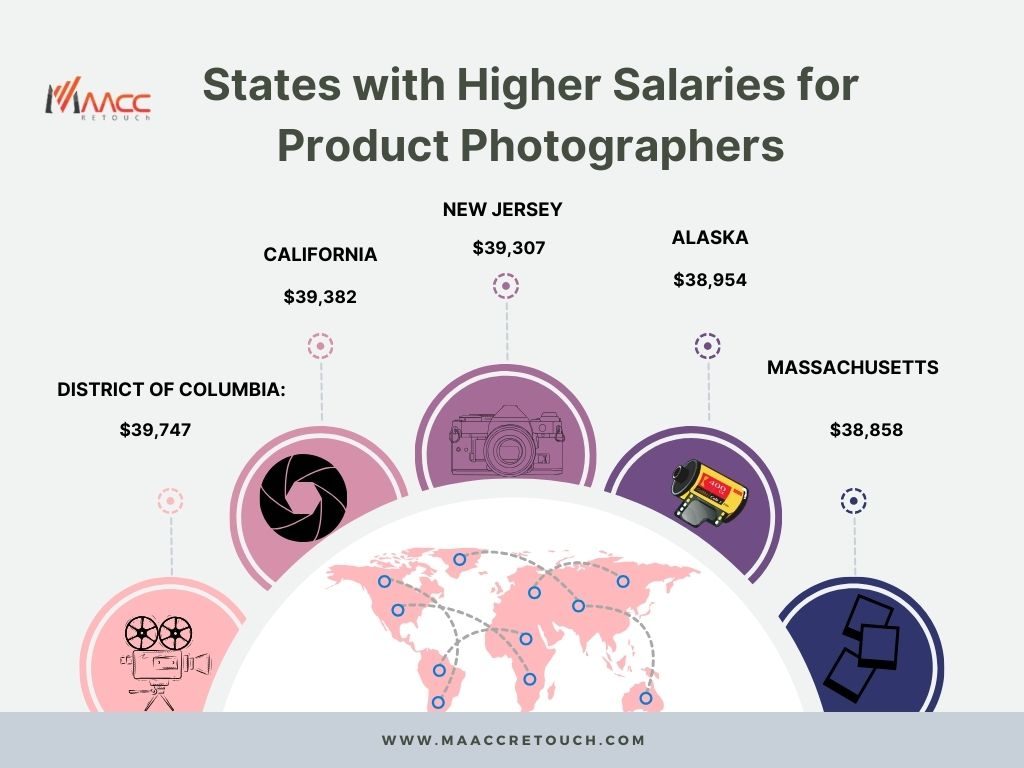
Product photographers tend to receive higher salaries in the United States in five specific states: the District of Columbia, California, New Jersey, Alaska, and Massachusetts.
Among all the states in the United States, the District of Columbia offers the highest job income for product photographers, surpassing the national average salary for this profession.
California and New Jersey rank as the second and third states with higher salaries for product photographers, respectively. The salary variations in this profession across the United States are closely tied to job demand and the cost of living in each region, exerting a significant influence on compensation levels.
Final words
Mastering the art of product photography requires a blend of technical skills and creative finesse. These tips from Maacc Retouch emphasize the importance of lighting, composition, and attention to detail.
Following these strategies photographers can elevate their product imagery, making products more appealing to potential customers. Whether for e-commerce, marketing, or showcasing your craft, these principles are invaluable in crafting stunning and effective product photographs that leave a lasting impression.

